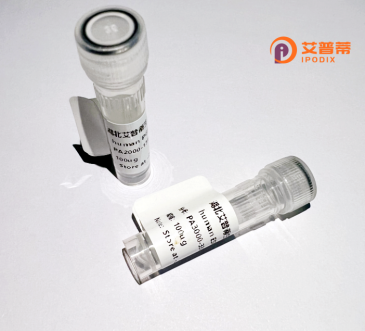
| 纯度 | >90%SDS-PAGE. |
| 种属 | Human |
| 靶点 | CARD11 |
| Uniprot No | Q9BXL7 |
| 内毒素 | < 0.01EU/μg |
| 表达宿主 | E.coli |
| 表达区间 | 481-580aa |
| 氨基酸序列 | KYFLPYHPPQRRMNLKGIQLQRAKSPISLKRTSDFQAKGHEEEGTDASPSSCGSLPITNSFTKMQPPRSRSSIMSITAEPPGNDSIVRRYKEDAPHRSTV |
| 分子量 | 36.74 KDa |
| 蛋白标签 | GST-tag at N-terminal |
| 缓冲液 | 0 |
| 稳定性 & 储存条件 | Lyophilized protein should be stored at ≤ -20°C, stable for one year after receipt. Reconstituted protein solution can be stored at 2-8°C for 2-7 days. Aliquots of reconstituted samples are stable at ≤ -20°C for 3 months. |
| 复溶 | Always centrifuge tubes before opening.Do not mix by vortex or pipetting. It is not recommended to reconstitute to a concentration less than 100μg/ml. Dissolve the lyophilized protein in distilled water. Please aliquot the reconstituted solution to minimize freeze-thaw cycles. |
以下是关于CARD11的关键参考文献摘要:
---
1. **《Oncogenic CARD11 mutations in human diffuse large B cell lymphoma》**
**作者:Lenz, G. et al.**
**摘要**:该研究揭示了CARD11基因的激活突变与弥漫性大B细胞淋巴瘤(DLBCL)的关系,突变导致组成型NF-κB信号通路的异常激活,促进肿瘤细胞存活和增殖。
---
2. **《Structural basis for assembly and activation of the CARMA1-BCL10-MALT1 signalosome》**
**作者:Qiao, Q. et al.**
**摘要**:通过晶体结构分析,阐明了CARD11(CARMA1)与BCL10、MALT1形成信号复合体的机制,揭示其在T细胞受体介导的NF-κB激活中的关键作用。
---
3. **《Germline CARD11 mutations in severe atopic disease》**
**作者:Ma, C.A. et al.**
**摘要**:报道了CARD11的遗传突变导致严重的过敏性疾病和免疫失调综合征,表现为T细胞功能缺陷及NF-κB信号通路异常。
---
4. **《The CARMA1 signalosome links the signalling machinery of adaptive and innate immunity in lymphocytes》**
**作者:Thome, M.**
**摘要**:综述了CARD11(CARMA1)在整合先天和适应性免疫信号中的作用,强调其在淋巴细胞活化及炎症反应中的核心地位。
---
以上文献均聚焦于CARD11的分子机制、病理关联及免疫调控功能,涵盖肿瘤学、结构生物学及免疫学领域。如需具体文献来源,建议通过PubMed或Google Scholar按标题检索。
CARD11 (Caspase recruitment domain-containing protein 11), also known as CARMA1. is a scaffolding protein critical for immune signal transduction. It belongs to the membrane-associated guanylate kinase (MAGUK) family, characterized by a conserved domain structure: an N-terminal caspase recruitment domain (CARD), a central coiled-coil domain, and a C-terminal PDZ domain. Primarily expressed in lymphocytes, CARD11 plays a pivotal role in antigen receptor-mediated activation of nuclear factor-κB (NF-κB) and mammalian target of rapamycin (mTOR) signaling pathways. Upon antigen recognition, CARD11 assembles the "CARD11-BCL10-MALT1" (CBM) complex, bridging receptor-proximal signaling to downstream transcriptional regulators.
Mutations in CARD11 are linked to immune dysregulation. Gain-of-function variants cause constitutive NF-κB activation, associated with B-cell lymphomas and autoimmune disorders, while loss-of-function mutations impair lymphocyte activation, leading to primary immunodeficiencies like severe combined immunodeficiency (SCID) or Omenn syndrome. Recent studies highlight its role in T-cell receptor (TCR) and B-cell receptor (BCR) signaling, emphasizing its dual regulatory mechanisms involving phosphorylation-dependent conformational changes. Due to its centrality in immune responses, CARD11 is explored as a therapeutic target for immune-related diseases and hematologic malignancies. Research continues to unravel its post-translational modifications, interactome dynamics, and tissue-specific regulatory networks.
×